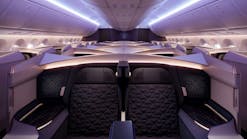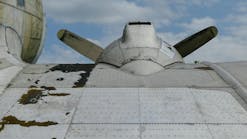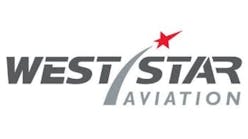It used to be that a wing wave or rapid tail deflection was all that was needed by the pilot of an aircraft to acknowledge a visual queue from a person on the ground. The evolution of electronic communications equipment is almost as dramatic as the evolution of the aircraft. In fact the radio age came about at almost the same time as the Wright Brothers took to the air. (Sorry but I could not resist the pun.)
Traditional aircraft communications are based on analog voice on either a Very High Frequency (VHF) or High Frequency (HF) radio waves. In the mid 1980s the use of data-based communications became a reality. Airspace management is transcending into the computer age and as new requirements evolve and the choice of communications technologies expand, regulating the world’s air traffic flow can safely become more automated. Aircraft are currently being equipped with communications technologies that transport data via satellite plus while they are on the ground; mobile communication and in some cases broadband networks can receive or broadcast strategic information regarding aircraft situation and even maintenance trends.
Aircraft communications are being expanded; in fact, in recent years a new abbreviation has surfaced. CNS ATM stands for “Communication, Navigation, and Surveillance and Air Traffic Management” which was created to support modernization of the dated and overload prone Air Traffic Control system.
Aircraft that are intended to transport passengers are equipped with radios that enable analog voice communications. This is currently and will be for the foreseeable future the primary means for pilots to communicate withdifferent entities of the Air Traffic Control (ATC) system.
ITU radio spectrum allocations
The allocation of radio spectrum is defined by the International Telecommunications Union (ITU) and relates the use of a frequency to a specific service. In the case of civil aviation there are separate ITU allocations for communications, navigation, and surveillance. Such differentiation between functions corresponds to the safety requirements for Air Traffic Control. The ITU has assigned frequencies for use by aircraft analog voice dialogue in parts of the “High Frequency” (3-30 MHz) band and in the 118-137 MHz section of the wider “Very High Frequency” range. Aircraft can use radios operating in the HF radio band for long-range communications as the signals are reflected by the ionosphere. Unfortunately when using HF the link audio quality is very poor due to this long propagation of the wave. Aircraft can use radios operating in the VHF band to communicate with other radios in line-of-sight coverage. These signals do not reflect off the ionosphere or penetrate obstacles such as mountains or buildings. The advantage of VHF over HF is that the link quality is much better and there is greater reuse of the frequency channel. The use of the word “analog” in relation to voice radio communications means that the changes in the sound of the voice are converted by the transmitter into corresponding variations in the radio signal and converted back by the receiver.
This analog system is simpler than more recent digitized voice systems that periodically measure the sound of the voice, convert the sound into a number in a predefined range, and send the numbers over the radio link. Aircraft VHF analog radios can use channels of varying width and the minimum width depends on the precision of the technology.
Aircraft have been using VHF radios for the past six decades and advancements in electronics have enabled the minimum channel width to be reduced from 100 kHz down to 8.33 kHz, which gives an exponential increase to the number of usable frequencies.
Aircraft Communications Addressing and Reporting System (ACARS)
Aircraft began to be equipped with computers in the 1970s and this led to the development in 1978 of a data communications system called the “Aircraft Communications Addressing and Reporting System” (ACARS).
Aircraft with ACARS can exchange data messages via a network of automated ground stations incorporating internal computers. Airlines first used the data link system to send movement reports to the ACARS service processors using the telex formats that operators had previously used to send those reports. ACARS are widely used today with airborne installations exceeding 10,000 aircraft.
ACARS units are connected to a VHF radio and in many cases, interfaced with satellite systems. This type of data communications is sent via conventional VHF radio waves that are received through a network of ground stations linked via a terrestrial network to a centralized data link service processor. This is what provides the connection to the ground systems of the users.
Data communications can also be sent via satellite networks but will ultimately link to the service processor that supports the VHF ACARS service. The function of the service processor is to route messages automatically between the user aircraft and ground systems, using mostly a fixed configuration of delivery addresses by message type for downlink messages and by memorizing the ground station to be used for uplink messages.
The main restriction on the ACARS system is that it uses character codes representing only printable characters. This limitation applied to all early generation data communications systems. This did not prevent the ACARS system from becoming the foundation of airline operations efficiency. However, the development of new radio communications technology and the need to support air traffic management, calls for newer technologies to be implemented.
Via satellite
Aircraft have been able to carry out voice and data communications via the Inmarsat satellites for more than 25 years. Until then, this satellite constellation was intended to provide communication services to ships. The number of aircraft currently equipped to use Inmarsat has exceeded 3,500 and is made up of airliners, business jets, and government aircraft.
Four satellites placed in geo-stationary orbit above the equator are centralized over the Pacific Ocean, Indian Ocean, Atlantic Ocean-East, and Atlantic Ocean-West. This constellation provides coverage through a “global beam” between 80 degrees above and below the equator.
The original Inmarsat Aeronautical service provides two modes, circuit mode supporting voice communications and packet mode supporting “always-on” data communications.
Aircraft operators use the Inmarsat circuit mode to offer voice service to passengers and flight deck crew. Aircraft operators use the Inmarsat packet mode, which provides a data rate approaching that of some home high-speed lines.
The move of aircraft communications from voice to data has motivated some operators of HF radio ground stations to install “HF data link” (HFDL) computers that enable the transport of ACARS data. Manufacturers of aircraft HF radios have added capabilities to support ACARS.
The new HF radios can switch between voice and data mode using the same components, but they are required to give voice communications precedence over data link. This has a tendency to limit the HFDL availability. This isn’t a commonplace application.
High Frequency radio data link has been found to provide better availability than HF voice on trans-Polar routes beyond the 80-degree North/South limit of Inmarsat satellite coverage. The HFDL capacity is only limited by the frequencies available in the HF band. The allocation of HF frequencies to data link has required a very complex co-ordination process and the system will quickly reach its limits.
The addition of data link capability to HF radio is a way for aircraft operators to get additional use out of the radios they still carry in order to meet ATC rules when most communications migrate from voice to data. However the HFDL system provides delivery of 95 percent of transmitted messages in three to four minutes compared to 20 to 30 seconds via satellite communications — so it is likely to be limited to providing a safety net in case of failure of satellite avionics, rather than a good alternative to satellite communications. The FAA Central Reporting Agency report as of July 2003 found 95 percent of uplink messages took four minutes, 20 seconds and 96 percent took up to 10 minutes.
VHF Digital Link
The term VHF Digital Link was adopted by the International Civil Aviation Organization (ICAO) Aeronautical Mobile Communications Panel (AMCP), at its first meeting in November 1991, to refer to digital communications carried on the Aeronautical VHF band. The Aeronautical VHF Band is the section of the Very High Frequency spectrum allocated to Aeronautical Service by the International Telecommunications Union. It is made up of the following two groupings: 108-118 MHz assigned to the purpose of radio-navigation and 118-137 MHz which is used for radio-communications.
The plan for VHF band to become a data carrier was proposed in the ICAO Future Air Navigation Systems (FANS) committee report issued in 1988. The airline community had recognized the benefits of aircraft data link communications 10 years before the FANS report and had implemented the VHF version of ACARS.
The ICAO reserved four VHF channels: 136.900, 136.925, 136.950, and 136.975 MHz for data communications worldwide. This later decision catered for the reservation of frequencies in order for such data service to be implemented in an environment when the existing aviation VHF spectrum was considered saturated and congested with existing VHF channels for air traffic analog voice.
VHF Digital Link (VDL) was put in motion by 1991 through the effort of the Aeronautical Mobile Communications Panel (AMCP) with a plan to increase the capacity of the VHF band; and develop a standard for an Aeronautical Telecommunications Network (ATN) data link service using VHF radio.
The AMCP has developed standards for VDL Modes 1-4 in which the modes provide different capabilities which currently have political divisions.
Mode 1 was created with the intent of using analog radios incorporating a device to install a coded signal on the existing carrier wave. This mode was never carried forward as analog radios were already viewed as dinosaurs. Further considerations brought about Mode 2 and 3 which present the position of the FAA wanting to use all new digital radios with a 25 kHz frequency spacing and the Eurocontol concept of going with 8.33 kHz frequency spacing.
On air transport aircraft, the communications, navigation, and surveillance functions will continue to be processed by separate devices:
- Communications: VHF data radio or a satellite data unit;
- Surveillance: Mode S transponder; and GNSS data link;
- Navigation: Global positioning systems and instrument landing systems multi mode receivers.
VHF Digital Link Mode 2 (VDL-2)
VHF Digital Link Mode 2 (VDL-2) was conceived in the early 1990s as a method of providing high-speed data communications to aircraft. From the outset VDL-2 was intended to support safety critical Air Traffic Control communications. In addition, airline operational data would also be supported by VDL-2; a service traditionally supplied using ACARS.
Global deployment of VDL-2 is now rapidly gaining acceptance by the airlines and Air Traffic Control agencies. In the United States, the FAA has been using VDL-2 in the Miami region with selected airlines prior to a nationwide rollout of the system. In Europe, Eurocontrol has strongly endorsed the operational benefits of VDL-2. Eurocontrol is offering financial assistance to help airlines install VDL-2 equipment, reduced route charges will follow for properly outfitted aircraft, and finally a mandate will be introduced to bring about full compliance, possibly, by the end of the decade.
The Swedish CAA and its commercial arm, Swedavia, promote the fact that the VDL Mode 4 system can simultaneously support communications, navigation, and surveillance applications. The combined functions used in the VDL Mode 4 system may be its greatest deterrent as each function has specific performance requirements that cannot be met by a combined system. Blending the CNS functions in a single Line Replaceable Unit (LRU) increases the probability that an aircraft will lose more than one of the functions, due to the failure of a single piece of airborne or ground-based equipment.
The FAA and Eurocontrol are in the process of creating a mutually agreeable “Future Communications” study that will address the requirements for a global future communications system to enable the implementation of enhanced ATM applications from today through 2030.
Who would have ever guessed that when Charles Taylor enabled the Wright Brothers to take to the air and then signaled them using hand gestures that he was in fact the first air traffic controller. Subsequent communications devices have been evolving as fast as aviation technology. I have always known aircraft technicians were great communicators in their own right.
Jim Sparks has been in aviation for 30 years and is a licensed A&P. His career began in general aviation as a mechanic, electrician and avionics technician. In addition to extensive hands on, Jim created and delivered educational programs for several training organizations and served as a technical representative for a manufacturer of business jets. Currently when not writing for AMT, he is the manager of aviation maintenance for a private company with a fleet including light single engine aircraft, helicopters, and several types of business jets.





